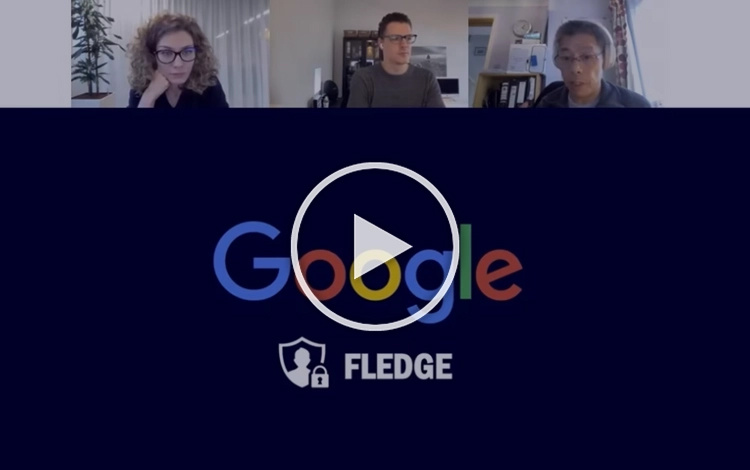5 Ways to Be More Relevant to Your Customers — Without Being Creepy
by Kalina Dancheva on 15.12.2016

There are no secrets on the internet. Your retailer knows what you will buy next before you do, and Twitter and Facebook accounts are being checked by customs officers. The truth is, most of us have simply accepted the fact that at some point our digital data is going to be used by someone trying to serve us something.
In marketing, it takes the shape of retargeting: the all-too-enticing practice of displaying ads on third-party sites to visitors who have browsed, then abandoned their websites, apps, or online baskets. Let us be clear from the start: retargeting isn't a good or bad practice in and of itself. Depending on how it's set up, retargeting can take the form of a helpful reminder, or it can be a menace chasing someone around the internet with a TR97 AeroPro tennis racket.
So what kind of retargeter are you? And is it possible to change your ways and still get results?
What does retargeting look like in real life?
It can be easy to forget what our digital marketing efforts actually look like in the real world. To that point, let's take a minute to imagine what a digital retargeting campaign would look like in real life:
You're at the mall and you idly wander into Sports Direct, a safe bet for buying a tennis racket. You glance at a few rackets, but you know deep down you don’t really play tennis much anyway. Without a backward glance, you leave the store in pursuit of more pressing pastimes, like getting a coffee.
As you sit down in the cafe, you spot a poster out of the corner of your eye and feel a sense of deja vu. Is it? You squint… yes, it is indeed a poster of a Slazenger tennis racket TR97 AeroPro. "That's a little weird," you think to yourself. Distracted, you wander out of the cafe, forgetting your coffee on the counter.
You round the corner and a man in a Slazenger t-shirt sidles up to you and whispers in your ear… “Hi [first name], we noticed you’ve been looking at the AeroPro tennis racket. Be sure to get it now while supplies last. We’re waiting for you.”
You refuse again. He chases you clear out of the mall with a TR97 AeroPro tennis racket.
It's a worthwhile thought experiment to consider how creepy it can feel to have something you briefly looked at once follow you around the internet for days.
Of course, that doesn't mean that we believe you should never retarget. In fact, we firmly believe it can be a wonderful and useful tool to engage your customers. So with the goal of creating an internet full of responsible marketing practices, here are 5 ways you can retarget without creeping out your would-be customers.
#1: Frequency caps
Balance out the conversation.
Just because someone has visited your website twice, it doesn’t mean they want to see your ads popping up on every single platform. Overexposure can quickly decrease your campaign’s performance and lead to banner blindness – meaning your prospect will ignore your advances completely. Frequency capping will limit the number of times a tagged user sees your ads.
If you unify your existing customer channels and the data on how your customers interact with them, you can control how, and how often, you communicate with an individual any given channel. This means you can filter and moderate your conversations across all channels to avoid coming on too strong, and instead match your customer's pace.
In the words of Rob van den Berg, Sr. Online Marketer at Nuon, Vattenfall: "If someone doesn't click after you've shown a banner for the 3rd time, it's pretty clear they don't find it relevant, so you'd better stop right there."
#2: Segmentation and experimentation
Respect individuality and take baby steps.
Sure, audience segmentation allows you to tailor ads to users in different stages of the purchase funnel. You can place retargeting tags on different pages of your website, tailor the creative components based on split testing a couple of different messages and images, and then deploy them depending on how warm the prospect is.
We can assume that if customer #1294 goes through the website, they will generally convert better with a follow-up email. But how do we learn from that assumption if we can’t see the bigger picture? What is the ‘average customer journey,’ and is it wise to reduce consumers to an average when they each have their own story?
Through smarter use of your 1st-party data, you can create multi-stage rules and apply them to a 3D consumer view across channels, rather than working with hypotheticals based on fragmented analytics. Instead of asking what the average customer journey is, ask "Is this the right message for this person, or this group?"
#3: Retargeted ads
Don't intrude — assist.
Taking a blanket approach or using 3rd-party data when trying to target your customers with ads is unlikely to achieve much. If you don’t want to creep out your customer, think about how long after an initial site visit retargeting ads might actually be effective. When does it become a pointless exercise? When does it stop being helpful?
With a credit card offer, the discovery stage might be 48 hours; but for a Carribean cruise, the consideration cycle may be slightly longer. By using a constant stream of real-time data fed through from all platforms to one unified hub, you can optimize the rules you create as your customers make decisions — learning from their movements and tweaking your campaign accordingly, like a considerate friend.
Responsible retargeting: an example
Laura is considering buying a Carribean cruise package for her husband’s birthday. Around two-thirds of the way down the conversion funnel, she has created an account and browsed a number of cruise options throughout the West Indies. She leaves the site and receives a campaign email that was set up to trigger if someone doesn't convert within a given timeframe. The email has been personalized based on her historical browsing habits, but despite that, Laura doesn't click through to any of the combined cruise packages. The machine learning mechanism takes note of this.
If Laura doesn’t contact the call center to book an appointment within three days, another rule will prompt a display retargeting campaign to be activated for relevant cruise offers.
After browsing her favorite sites for two days, however, Laura sees an ad prompting her to call and receive a 20% discount on a Luxury Carribean Cruise package. The operator answering her call has access to all of her browsing preferences, including where she wanted to go, where she wants to go now, who she’s going with, and in what season she plans to travel.
Now that's hyper-personalized customer service.
By looking at the bigger picture and using a real-time view, omnichannel view of your prospect’s behavior, you can catch them in the discovery phase, hold their hand gently, make sure you don’t let your brand disconnect, and know at what point to let go.
#4: Burn tags
Realize when you’ve already won.
Too many businesses continue to serve ads to people after they've already converted. Especially when the solution is so straightforward: use a snippet of code, place it in your post-transaction page, and untag any users who have made a purchase to ensure you stop serving them ads.
Of course, this tactic will only get you so far. It's great for purchases made via digital channels, but what happens when someone buys something in-store or over the phone? By using a marketing platform to connect your offline CRM system to your digital access points, you can also measure old fashioned goods-for-money exchanges through an actual till. You can even incorporate phone transactions into your online marketing burn tags. No more needless ads served.
Using a marketing platform to access cross-channel customer behavior by linking bannering to your CRM will also allow save on budget: no need to pay for wasted impressions if you know the job has been done. And no need to use paid channels if you have enough information to use owned channels. Once the cool-off period has lapsed and your customer lifecycle begins again, why not email them a discount code for a relevant product to thank them for their continued loyalty?
#5: Look within
Make customer-centricity an organizational goal.
In less than 20 years, we’ve gone from slower-than-slow dial-up internet to 4K videos seamlessly streaming to our 4G smartphones. Technology is developing at an exponential rate, and the way we interact with our customers must keep pace — not only in terms of how we retarget and guide them along their journey, but how we think of them from a business perspective.
Now is the time to take a long, introspective look at processes and silo-based KPIs, and start shifting to a cross-channel, customer-centric organization. Now is the time to put real personalization into practice.
You May Also Like
These Related Stories

What is Google's Privacy Sandbox and What Do Digital Marketers Need to Know?

What is Google's Protected Audience API and how will it impact programmatic advertising?


.png?width=786&height=265&name=Relay42%20Demo%20Banner%20(1).png)